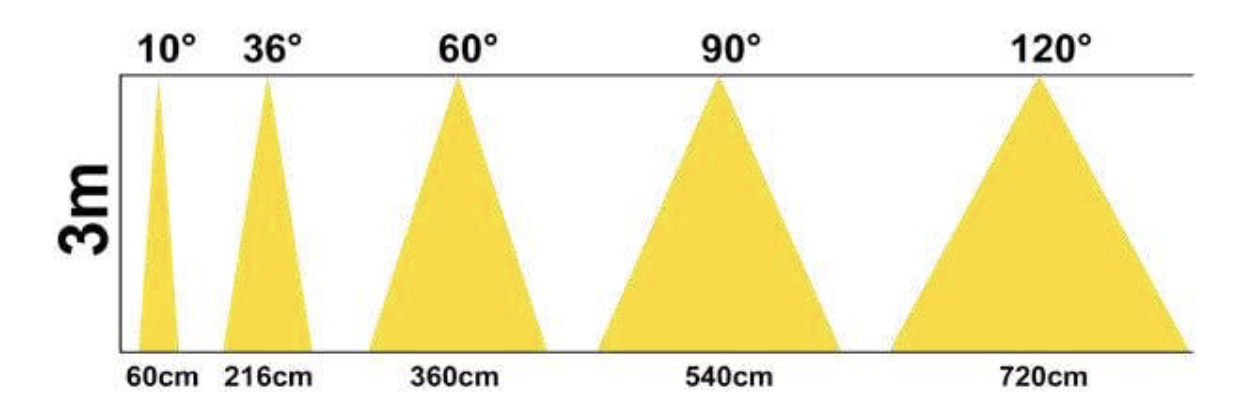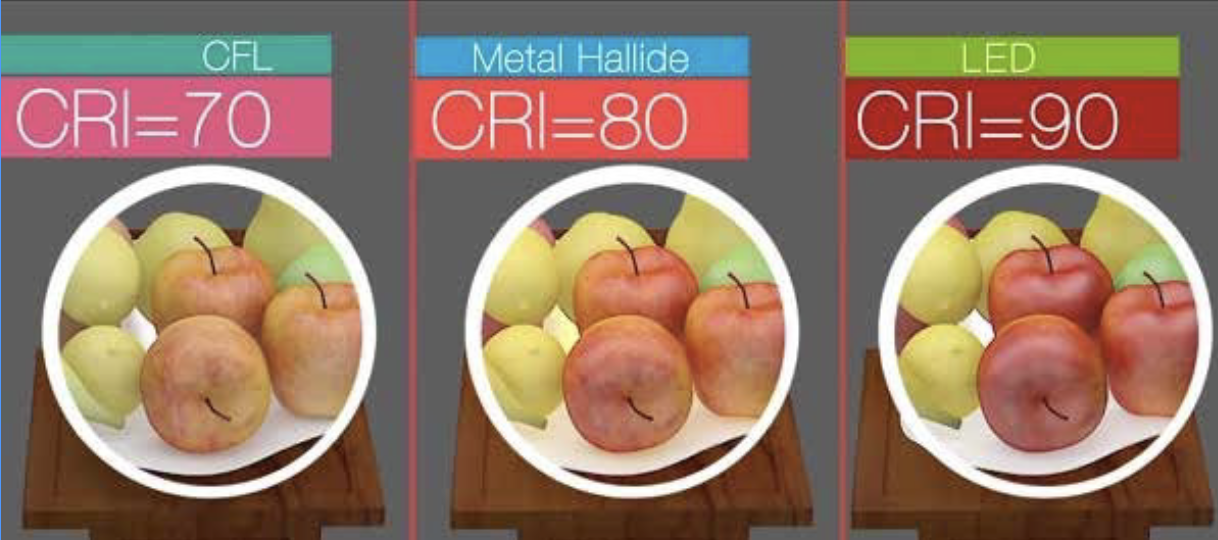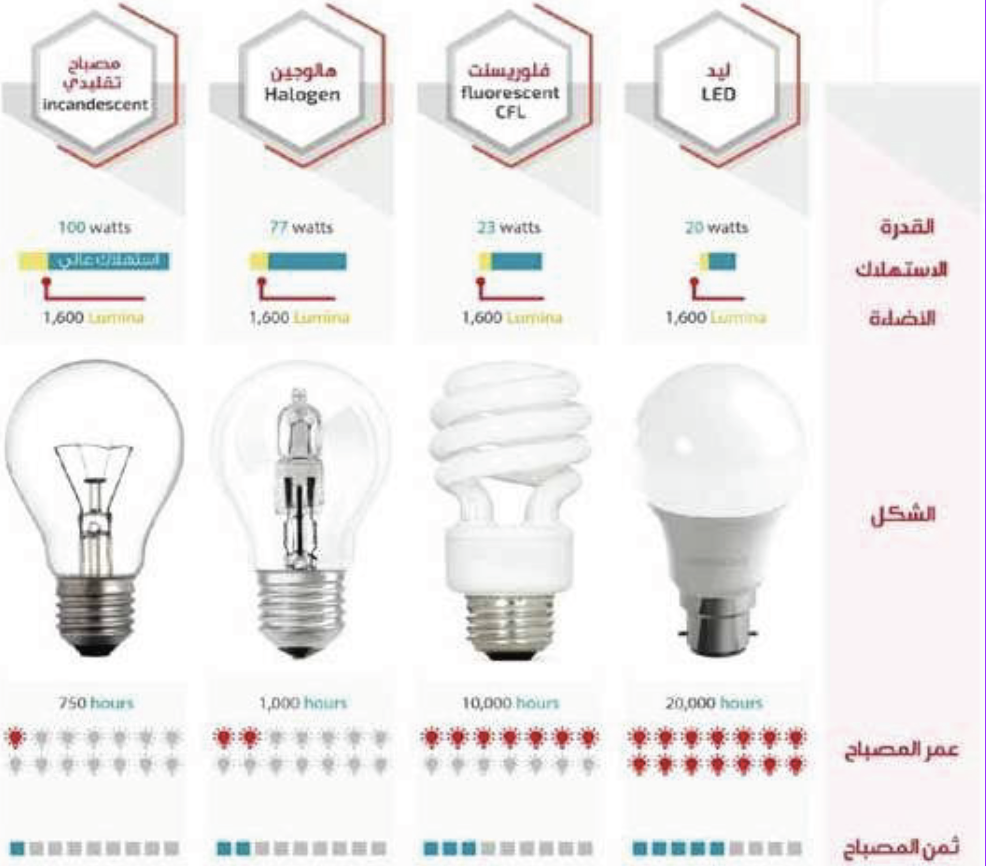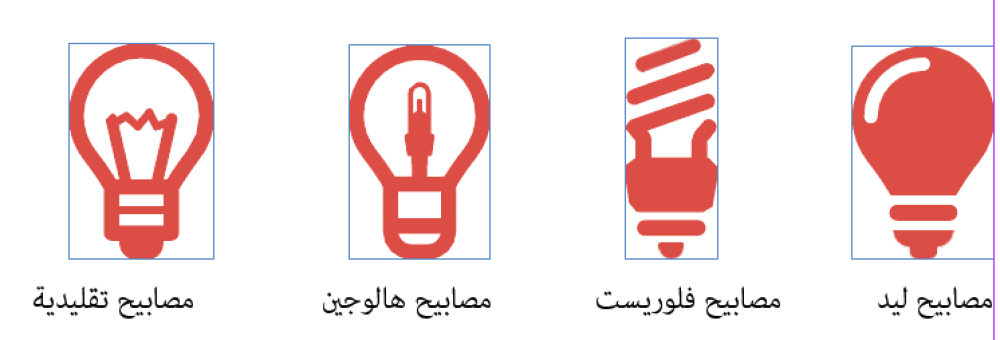When purchasing lighting units, whether bulbs or spotlights, many consumers struggle to understand the information on the product packaging. This can lead to difficulty in using the lighting unit correctly, ensuring optimal use of each product's specifications.
This forces consumers to entrust the matter to an electrician who distributes lighting randomly, without relying on the specifications of each product and the method of its use.
Therefore, Mishkati Lighting and Electrical Company has issued this booklet to serve as a comprehensive guide for its customers and others . This comes as part of its belief in its responsibility to educate consumers about the types of lighting, how to choose the appropriate lighting units for each room, and how to distribute lighting correctly to make the most of each unit's specifications.
Chapter One: Important Definitions
This section contains very important definitions for the consumer.
To be able to absorb the data recorded on the carton
Product
!
Volt:
It is a unit of measurement of electrical power and is symbolized by the symbol 7.
We have two types of it in the Kingdom of Saudi Arabia:
Old type 110 volt
New type with 220 volt power
It should be noted that installing any gear on an inappropriate system will damage the device.
Example:
* Devices labeled 100-120V only work on the old system.
* Devices labeled 210-240 V work on the new system only.
* Devices labeled 100-240V work on both systems.
Ampere:
It is a unit of measurement for the intensity of electric current and is distinguished by the symbol, as it expresses the intensity of the current
Electricity passing through two parallel wires in a vacuum, one meter apart from each other
one
It represents the difference in the time to obtain the required amount of energy, for example:
* If fully charging a mobile phone takes two hours using a charger that transmits current at a strength of 1 ampere per second, then charging the same mobile phone takes an hour and a half using a charger that transmits current at a strength of 0 amperes per second.
Watt:
It is a unit of energy measurement and is symbolized by the symbol W.
It represents the product of volts and amperes, watts divided by volts x amperes, for example:
0 If we pass an electric current with a strength of 220 volts and a strength of 1 ampere, the resulting amount of energy will be
It is 1100 watts
0 Therefore, it is the unit used to calculate the electricity bill, as it represents the amount of energy consumed and is considered one of the most important factors in comparing the economy of bulbs, as a halogen bulb consumes 40 watts, while a 5 LD bulb consumes only 5 watts to provide the same lighting.
Lumen:
It is the unit of measurement of the luminous flux produced by a specific lighting unit and is symbolized by the symbol Im.
It expresses the amount of light produced by the lighting unit and is also considered one of the most important factors in comparing the economics of lamps, for example:
* A 40-watt halogen bulb produces 480 lumens, which is equivalent to 12 lumens per watt.
* 5 watt LED bulb produces 475 lumens, which is equivalent to 95 lumens per watt.
Which shows that the output of LED bulbs in terms of the amount of light per watt is much higher than that of halogen bulbs.

Lux:
It is a unit of measurement for the intensity of light inside a specific room and is symbolized by xa.
The required lux varies from room to room depending on the room's uses, for example:
* It is preferable to provide lighting with an intensity of 200 to 300 lux in bedrooms.
* It is preferable to provide lighting with an intensity of 300 lux to 750 lux in kitchens.
Lighting intensity Room type
From 200 lux to 300 lux bedroom - cafe - restaurant
Not less than 50 lux and not more than 200 lux storage room
Not less than 300 lux and not more than 500 lux per semester - study room - library - office
Not less than 100 lux and not more than 300 lux hall - bathroom
Not less than 50 lux and not more than 100 lux parking spaces - stairs - corridors
Not less than 300 lux and not more than 750 lux kitchen - workshop
Not less than 500 lux and not more than 750 lux
We recommend following the international standard for lighting intensity. Specialists have developed a table that shows the appropriate lighting intensity for each room according to the activity, as shown in the table:
Bedroom - Cafe - Restaurant from 200 lux to 300 lux
Storage room of not less than 50 lux and not more than 200 lux
Classroom - Study room - Library - Office Not less than 300 lux and not more than 500 lux
Hall - Bathroom of not less than 100 lux and not more than 300 lux
Parking spaces - Stairs - Walkways not less than 50 lux and not more than 100 lux
Kitchen - Workshop of not less than 300 lux and not more than 750 lux
Laboratory not less than 500 lux and not more than 750 lux
Beam angle:
It is the angle of light emission from the lighting source and is the main factor in determining the use of the lighting source. Lighting sources with a small angle are used as focused lighting, while lighting sources with a large angle are used as general lighting.
An approximate equation to calculate the propagation of light on a surface:
Light spread on the surface = (2 x illumination angle) x height

Kelvin :
It is a unit of measurement for color temperature and is symbolized by the symbol K.
It expresses the difference in the colors of light that we observe, so that the lower the Kelvin value, the more the color tends towards yellow, then towards red, and the higher the Kelvin value, the more the color tends towards white, then towards blue, as in the image below.

Color Rendering Index (CRI):
It is the effect of lighting on the appearance of the color of objects compared to the appearance of the color in sunlight. It is one of the factors that differentiate between types of lighting in terms of quality, as it has a great effect on displaying the natural color of objects. The maximum value for the color rendering index is 100, which is for sunlight. It is not recommended to buy lighting with a color rendering index (CRI) of less than 80.

the age
DefaultLife span :
This is the approximate period of time that the bulb/flashlight will operate without malfunctions.
It is also considered one of the ways to compare the economics of lamps, as in the case of the availability of lighting with a long lifespan, there is no need to replace it within a short period, and the opposite is true in the case of the availability of lighting with a short lifespan, this requires replacing it every period due to the presence of malfunctions in it, which causes an additional cost. LED lamps are characterized by the ability to work up to 80,000 hours, which is a long period compared to other types of lighting.
Number of years of operation = lamp lifespan / number of working days multiplied by the number of daily working hours
IP protection level:
It indicates the lamp's resistance to dust and water. The number on the left indicates the degree of resistance to solid objects and dust, while the number on the right indicates the degree of resistance to liquids and water, as shown in the figure below:
Liquid materials: Degree of water resistance of the device:
0 No protection | 1 Protection against water drops falling vertically on the device | 2 Protection against water drops falling vertically on the device tilted at 15 degrees | 3 Protection against water spray directed at the device at a 60-degree angle | 4 Protection against water spray directed at the device at any angle | 5 Protection against strong water jets on the device at any angle | 6 Protection against strong water jets and sea waves | 7 Protection against temporary immersion of the device under water for 30 minutes at a maximum of 3 feet | 8 Full protection for immersion of the device under water up to 13 feet - 4 meters
Solids: The degree of resistance of the device to solid objects.
0 No protection | 1 Protection against solid objects larger than 50 mm, such as a hand | 2 Protection against solid objects larger than 12.5 mm, such as a finger | 3 Protection against solid objects larger than 2.5 mm, such as a wire | 4 Protection against solid objects larger than 1 mm, such as a blade | 5 Limited protection against dust, which can enter but does not damage the device | 6 Full protection against dust and solid objects
Example: IP54 No. 4 means protection against water spray directed at the device at any angle, and No. 5 means limited protection against dust that can enter but does not damage the device.
Chapter Two: Types of Lighting
This section explains lighting classifications in terms of technology.
And the type so that the consumer can choose the appropriate lighting.
Lighting techniques:
Here we talk about the most common and widely used lighting technologies in homes:

!
LED lamps, fluorescent lamps, halogen lamps, conventional lamps
The following figure shows the difference between each of them in terms of energy consumption, lifespan, and price:

LED technology is the latest lighting technology, making it the most energy-efficient directly in terms of producing the highest amount of light with the lowest electricity consumption, and also indirectly as it does not produce any heat, making it a factor that helps in air conditioning the room, unlike traditional lamps and halogen lamps that produce heat, which makes the air conditioner operate at its maximum power all the time. LED technology is also considered the best lighting technology in terms of economy as it has the longest lifespan, which makes it necessary to replace it at long intervals, unlike other technologies that need to be replaced continuously.
Public lighting:
It is the lighting that produces a large amount of lighting at a large angle, and therefore it is used as the main light source in the room. It has many shapes and types, as there are factors that determine the appropriate type for use, such as (the activity) of the room - the type of ceiling - the installation location) as shown.
Anti-glare spotlight
Suitable for home use.
Suitable for gypsum ceilings, taking into account the opening size.
Downlight
Suitable for office use.
Suitable for gypsum ceilings with consideration
Hole size.
60x60 lighting
Suitable for office use.
Suitable for concrete ceilings.
Anti-glare + GU10
Combination of frame + bulb
The bulb is replaced only in case of malfunction.
Suitable for home use.
Track Light
Suitable for exhibitions and shops
Spot lighting:
It is the lighting that produces a medium amount of light at a small angle and is characterized by its flexibility of movement, and therefore it is used to clarify certain things in the room, such as a painting or flowers, by highlighting them. It has many shapes and types, and the factor that determines the appropriate type is the activity of the place, as shown:
Decorative lighting:
It is a type of lighting that produces a small amount of light and is used only to give a decorative look to the room. It is suitable for use in homes, offices, and exhibitions and comes in two main forms, as shown:
Decorations
Available in more than one color and more than one size, it is suitable for walls, floors and shelves.
Wall lighting:
It is the lighting that is installed on the walls and there are two main purposes for this lighting, which are: general lighting, in the event that it is installed on stairs, corridors, or next to the mirror, which makes it the main source of lighting in the place
Decorative lighting, when installed in gardens, on fences or entrances, is available in many shapes and designs, as shown:
Chapter Three: Lighting Distribution Tips
This section contains very important tips for the consumer to be able to distribute the lighting sufficiently by himself.
Suitable for every room.
!
Calculating the appropriate number of spotlights for the room
This is usually done using specialized lighting distribution software such as DIALux, but the number of spotlights can be calculated approximately, but not precisely, using the following equation:
Number of spotlights = Room area X Amount of lighting required X 1.2 / Amount of lumens produced by the spotlight
1- Room area: multiplying the length of the room by its width.
2- The required amount of lighting: It can be obtained from the lighting quantities table in the Lux section of Chapter One.
3- The amount of lumens produced by the spotlight: It is written on the spotlight either in total as 2700 (Im), which is the amount of lighting produced by the spotlight, or in detail (90) Im/W), which is the amount of lighting produced by one watt. In this case, the total is the product of the lumens per watt multiplied by the watts of the spotlight.
Illustrative example:
We have an office room that is 7 meters long and 5 meters wide, and we want to calculate the number of 30-watt spotlights suitable for the room.
Luminous output (Im/W90)
1. Room area = 7 * 5 = 35 meters
2. Average amount of lighting required for an office room = 400 lux
3. The amount of lumens produced by the spotlight = 30 watts * 90 lumens per watt = 2700 lumens
35 * 400 * 1.2 16800
Number of spotlights = ـــــ = ـــــ = 6.2, which is approximately equivalent to 6 spotlights
2700 2700
comments
The equation is valid for calculating the amount of general lighting in rooms whose height does not exceed 3 meters only, and is not valid for calculating decorative lighting or rooms whose height exceeds 3 meters.
The equation is not 100% accurate like lighting distribution software but it is much better than random installation.
To obtain good, sufficient and unobtrusive lighting, it is necessary to follow the lighting distribution tips along with the equation.
Avoid using low-angle lighting as a general lighting source in a room, as it does not distribute light properly in the room, which results in more shadows, which is annoying to the eyes and distorts the view.
Avoid using random, focused lighting, but use it to highlight only the valuable things that you want to highlight inside the room.
Lighting with a color temperature between 2700 K and 4000 K is suitable for use in homes, as it is easy on the eyes and matches the warmth of a family. Lighting with a color temperature between 4500 K and 6500 K is suitable for use in offices and exhibitions, as its color helps increase attention and awareness.
Avoid using overhead lighting to illuminate the bathroom mirror, as this can cast shadows on your face as the light rays hit your head before reaching your face. It's best to use wall-mounted lighting to illuminate the bathroom mirror, as these lights spread directly onto your face without obstruction, making your vision clearer.
It is natural for the upper parts of the kitchen to block the general lighting from the space between them and the lower parts. Therefore, it is recommended to install decorative lighting below the upper parts to illuminate the space.
It is recommended to leave sufficient space between lighting units and walls to avoid distorting the view due to shadows on the wall. This space should not be less than 80 cm for focused lighting and not less than one meter for general lighting. This space varies depending on the lighting angle. The larger the lighting angle, the greater the space required.
It is recommended to use lighting fixtures with reflectors because they do not cause glare that is annoying to the eyes.
Avoid placing any lighting units directly above the bed, as they are very annoying and cause insomnia.
General lighting in the rest of the rooms
meter
General lighting units shall be located at least one meter away from walls.
General lighting in the living room and sitting room
One and a half meters
General lighting units should be at least 1.5 meters away from walls to avoid shadows over seating.

